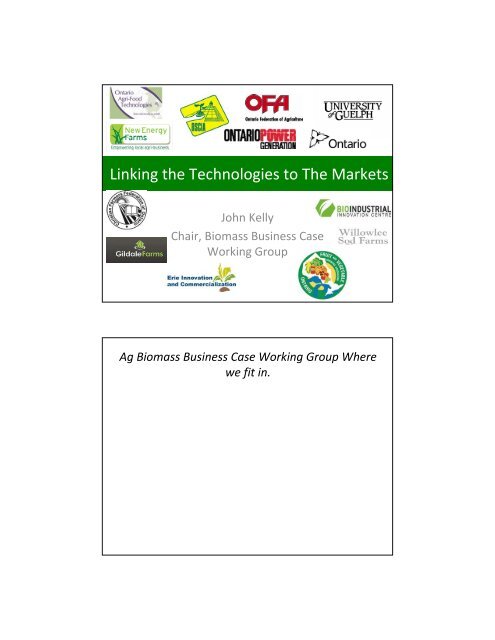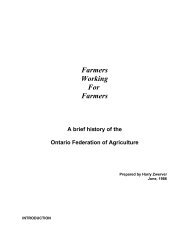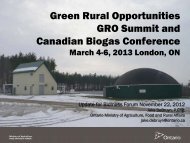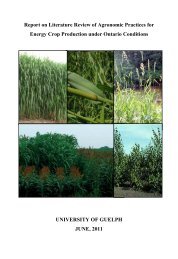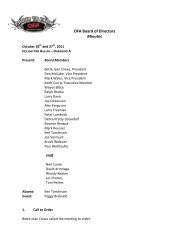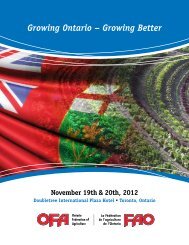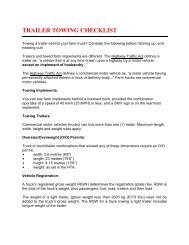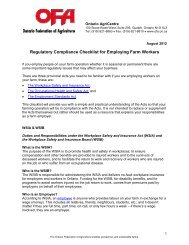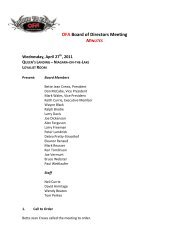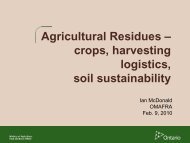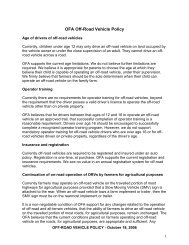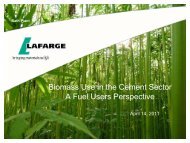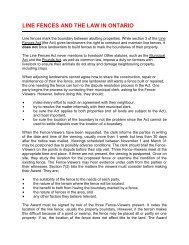Biomass Working Group Needs - Ontario Federation of Agriculture
Biomass Working Group Needs - Ontario Federation of Agriculture
Biomass Working Group Needs - Ontario Federation of Agriculture
Create successful ePaper yourself
Turn your PDF publications into a flip-book with our unique Google optimized e-Paper software.
Linking the Technologies to The Markets<br />
John Kelly<br />
Chair, <strong>Biomass</strong> Business Case<br />
<strong>Working</strong> <strong>Group</strong><br />
Ag <strong>Biomass</strong> Business Case <strong>Working</strong> <strong>Group</strong> Where<br />
we fit in.
Why are we here?<br />
The key objective <strong>of</strong> this session is to get input<br />
from participants on the key questions the<br />
Business Case WG needs to answer in order<br />
toobjectively assessthe business case<br />
Terms <strong>of</strong> Engagement<br />
• A Business Case <strong>Working</strong> <strong>Group</strong> was formed<br />
to objectively coordinate the economic<br />
feasibility analysis.<br />
• The working group is to draft the business<br />
case with timelines over the summer, and<br />
report back to the Steering Committee at the<br />
next meeting (targeting late Sept.).
Development <strong>of</strong> a Business Case<br />
• Economics<br />
– Financial analysis at each step in the agricultural<br />
biomass value chain<br />
– Business risk management<br />
– Impact on competing uses for agricultural biomass<br />
– Competitiveness with forestry biomass, USsourced<br />
biomass and other sources <strong>of</strong> energy<br />
– Investment required by farmers, consolidators<br />
other core participants throughout the supply<br />
chain<br />
From the Draft Terms <strong>of</strong> Reference: Business Case <strong>Working</strong> <strong>Group</strong><br />
Development <strong>of</strong> a Business Case<br />
• Risks <strong>of</strong> proceeding/not proceeding<br />
• Deliverable schedule<br />
• Environmental and societal considerations<br />
• Technology related considerations<br />
• Other items identified in the Steering<br />
Committee’s Draft Work Plan (June 14, 2010)<br />
From the Draft Terms <strong>of</strong> Reference: Business Case <strong>Working</strong> <strong>Group</strong>
The Situation When We First Met<br />
• <strong>Biomass</strong> was the preferred position for OPG as a<br />
replacement for coal (as per gov’t mandate)<br />
• <strong>Biomass</strong> pellets were to be the fuel <strong>of</strong> choice<br />
– The recipe for the pellets was unknown<br />
– Handling / storage were identified as issues<br />
– Silicates and boiler life were a consideration<br />
• Life cycle analysis <strong>of</strong> carbon and other elements were to<br />
be integral to adoption<br />
• Aggregation<br />
• <strong>Biomass</strong> choices were based mostly upon perennial grass<br />
crops or crop residues<br />
• OPG and farmers were not on the same page<br />
Developing a new product<br />
Simple Value Chain<br />
Technology<br />
Provider<br />
Grower<br />
Aggregator<br />
End User<br />
Consumer
Erie Innovation and Commercialization<br />
Development <strong>of</strong> a Business Case<br />
• Value Chain analysis<br />
• Competitive pressures<br />
– Source <strong>of</strong> biomass<br />
• Forestry, perennial and annual agricultural crops<br />
– End use <strong>of</strong> biomass<br />
• Cellulosic ethanol, fibre, bedding, international markets<br />
etc<br />
– Cost <strong>of</strong> Production<br />
– End Market Analysis<br />
– Opportunity cost <strong>of</strong> other crop selection
Benefits <strong>of</strong> Perennial Crops – Agronomic/Environmental<br />
All perennial crops result in:<br />
• Soil improvement<br />
• Reduced soil erosion<br />
• Greater carbon<br />
sequestration<br />
• Less chemical applications<br />
• Productive for 15-20 years<br />
once established<br />
Source AungOo, 2010<br />
Tall Grass Prairie
Miscanthus giganteus<br />
Miscanthus trial on an INRA test field. Credit:INRA/S.Cadoux<br />
Switchgrass
Development <strong>of</strong> a Business Case<br />
• Value Chain Analysis ‐ Returns<br />
– Technical providers<br />
– Growers<br />
– Aggregators<br />
– End users (GHVG, Lafarge, OPG, Residential,<br />
Institutional, others?)<br />
– Consumer analysis and costing<br />
Development <strong>of</strong> a Business Case<br />
• Competitive Pressures: Source <strong>of</strong> <strong>Biomass</strong><br />
– <strong>Ontario</strong> based versus international sources<br />
– Forestry versus agricultural sources<br />
• Miscanthus, switch grass, big blue, sorghum, crop<br />
residues<br />
– Unforeseen impacts (environmental, soil, Carbon<br />
balance etc)<br />
– Do we consider the food<br />
versus fuel debate?
Development <strong>of</strong> a Business Case<br />
• Competitive Pressures: End Use <strong>of</strong> <strong>Biomass</strong><br />
– Large institutional electricity generators (OPG),<br />
small generators<br />
– Competitive uses <strong>of</strong> biomass<br />
• Polycomposites<br />
• Industrial (insulation, bedding, others)<br />
• Cellulosic ethanol<br />
– Carbon credits and value<br />
– International Markets<br />
Endex Wood Pellet Futures Markets<br />
ENDEX Wood<br />
Pellets Bid /T Ask /T Sett /T<br />
11-Apr € 125.75 € 135.07 € 130.41<br />
11-May € 124.75 € 133.83 € 129.29<br />
11-Jun € 125.17 € 133.55 € 129.36<br />
Q2-11 € 124.58 € 133.94 € 129.26<br />
Q3-11 € 124.50 € 134.77 € 129.64<br />
Q4-11 € 127.50 € 136.45 € 131.98<br />
Cal-12 € 127.71 € 137.09 € 132.40<br />
Cal-13 € 130.14 € 140.20 € 135.17<br />
Cal-14 € 133.17 € 143.56 € 138.36
Development <strong>of</strong> a Business Case<br />
• Cost <strong>of</strong> Production<br />
– Seed / plug inputs<br />
– Agronomic inputs (fertilizer, pest control products,<br />
land preparation, etc)<br />
– Fuel<br />
– Labour<br />
– Harvest<br />
– Storage<br />
– Capital costs<br />
– Cost <strong>of</strong> money invested<br />
– Risk management<br />
• Fibre collection – this is switch grass
<strong>Biomass</strong> conversion is the Key to the Vision<br />
Needed: non‐food parts <strong>of</strong> food crops (wheat straw, wood chips, recycled paper, corn stalks,<br />
etc.) and dedicated energy crops requiring low in‐puts (switch grass, miscanthus, others)<br />
Major issue will be feedstock accumulation, storage, and handling<br />
Development <strong>of</strong> a Business Case<br />
• Aggregation<br />
– Fuel<br />
– Labour<br />
– Storage<br />
– Capital costs<br />
• Equipment and equipment durability<br />
• Facility and capacity<br />
• Location<br />
– Cost <strong>of</strong> money invested<br />
– Risk management<br />
– What about Torrefaction?
Straw Processing Line<br />
Development <strong>of</strong> a Business Case<br />
• End Market Analysis<br />
– Who are the end users – really?<br />
• What is the real opportunity? Not just OPG….<br />
• What do they want (for example – pellets vstorrefied<br />
product)?<br />
– Who are the price setters and what is the impact<br />
<strong>of</strong> policy<br />
– What are the impacts <strong>of</strong> competitive fuel sources<br />
(ie Natural Gas)<br />
– What are the impacts <strong>of</strong> other green energy<br />
sources (wind, solar, geothermal etc)?
Erie Innovation and Commercialization<br />
Erie Innovation and Commercialization
Erie Innovation and Commercialization<br />
Erie Innovation and Commercialization
Erie Innovation and Commercialization<br />
Erie Innovation and Commercialization
Erie Innovation and Commercialization<br />
Erie Innovation and Commercialization
Erie Innovation and Commercialization<br />
Erie Innovation and Commercialization
Erie Innovation and Commercialization<br />
Erie Innovation and Commercialization
What Drives Us? <strong>Biomass</strong> Value.<br />
Scientist<br />
Entrepreneur<br />
Finance<br />
Engineer<br />
Government<br />
Distributor<br />
Grower Aggregator End User Consumer<br />
Farmers<br />
NGO<br />
GROWER ECONOMY<br />
RURAL ECONOMY<br />
URBAN ECONOMY<br />
GOVERNMENT ECONOMY<br />
TAX PAYER TAX PAYER GENERATOR TAX PAYER<br />
CARBON ECONOMY<br />
SEQUESTERER RELEASER RELEASER<br />
RELEASER<br />
The Elephant in the Room for the <strong>Biomass</strong><br />
Business Case is the Price <strong>of</strong> Natural Gas<br />
Image from http://spongeist.files.wordpress.com
Global Shale Gas Deposits<br />
June 2010<br />
North America<br />
3840 Tcf<br />
South America<br />
2116 Tcf<br />
W. Europe<br />
509 Tcf<br />
Central and<br />
E. Europe<br />
39 Tcf<br />
Middle East &<br />
North Africa<br />
2547 Tcf<br />
Sub‐Saharan Africa<br />
274 Tcf<br />
Former Soviet Union<br />
627 Tcf<br />
Central Planned Asia<br />
And China<br />
3526 Tcf<br />
Asia / Pacific<br />
2625 Tcf<br />
http://247wallst.com/2010/06/25/foreign‐investors‐buy‐into‐shale‐gas‐play/<br />
Questions for the <strong>Biomass</strong> Business<br />
Case <strong>Working</strong> <strong>Group</strong><br />
• Can syn gas generated from biomass get the same<br />
incentives (PPA) as energy from AD systems.<br />
• Feed in tariff for heat like similar to what is materializing in<br />
the UK<br />
• Who is going to financially back any opportunity on the<br />
growing side.<br />
• One <strong>of</strong> our main difficulties in getting growers to move in this<br />
direction is ensuring the price for the biomass is bankable and<br />
guaranteed.<br />
• Agricorp Crop Insurance<br />
• Much work needs to be done on this.<br />
• If policies are created will there be greater incentives for ag<br />
produced biomass?? Domestic supplies???
Questions for the <strong>Biomass</strong> Business<br />
Case <strong>Working</strong> <strong>Group</strong><br />
• Is there a business case if ag biomass pellets from<br />
<strong>Ontario</strong> are paid $ 175/tonne delivered at Rotterdam,<br />
Netherlands?<br />
• Supply/demand and price projections <strong>of</strong> corn, soybeans<br />
and wheat for next 10 years; which can be used for<br />
estimating risks and opportunity cost <strong>of</strong> growing non‐food<br />
biomass<br />
• Hay and other feed demand from the growing beef<br />
industry in developing countries (US is currently exporting<br />
DDG from corn ethanol plants to China for feed; current<br />
price <strong>of</strong> DDG is ~ $ 200/tonne)<br />
Questions for the <strong>Biomass</strong> Business<br />
Case <strong>Working</strong> <strong>Group</strong><br />
• Feasibility <strong>of</strong> a distributed biomass power generation<br />
plant (~ 100 MW) and process integration opportunities<br />
(such as combined heat and power, integrating with grain milling and<br />
vegetable greenhouse, etc.).<br />
• Job creation and macro‐economic benefits and price impact<br />
from creating the distributed biomass power generation<br />
capacity (let's say 5,000 MW) in <strong>Ontario</strong><br />
• Integrating with overall waste management strategy;<br />
– i.e AD plant for municipal green waste combined with manure AD<br />
and agricultural residuals power generation<br />
• Integrating with bio‐fibre and bio‐composite plants
Will the environment and political will have<br />
more weight than the economic position?<br />
Economics<br />
Environment<br />
Political Will<br />
<strong>Ontario</strong><br />
Generated<br />
Power<br />
<strong>Biomass</strong> Advantages….<br />
• Cost vs other “green” technologies.<br />
– Using wind as an example (17.4 c/Kwh)<br />
– Coal price at 4.5 c/Kwh ($65 per Tonne)<br />
– Torrefied equivalent at 17.4 c/Kwh = 17.4/4.5 x 65 = $251 /T<br />
Coal equivalent<br />
• Torrefied product is 99% equivalent to coal.<br />
• Money stays within <strong>Ontario</strong><br />
– Investments in infrastructure have direct impact on <strong>Ontario</strong><br />
Economy<br />
– Investment dollars circulate back to <strong>Ontario</strong> and does not<br />
leave the province through FDI<br />
– Revenue stream for farmers<br />
– Creation <strong>of</strong> new industries and value chain
<strong>Biomass</strong> Advantages….<br />
• Only Carbon sequestration technology<br />
– Solar, wind do not have C sequestration and positive<br />
impact on GHG<br />
– For every tonne <strong>of</strong> product taken <strong>of</strong>f the field, one tonne is<br />
below the ground<br />
• Only On Demand green technology<br />
– Solar, wind depend upon sun and wind movement<br />
respectively and cannot be turned on at a moments notice<br />
• No Negative Cash Flow issues<br />
– If electricity is not needed, it is not generated.<br />
– Pay only for electricity that is generated, and not forced to<br />
sell electricity at a loss<br />
<strong>Biomass</strong> Advantages….<br />
• No write <strong>of</strong>f <strong>of</strong> a $7B asset for the Province <strong>of</strong><br />
<strong>Ontario</strong><br />
• <strong>Ontario</strong> Jobs<br />
• No negative environmental impact<br />
– Natural gas spills<br />
– Solar panels on agricultural land<br />
– Wind mills on agricultural land<br />
– Keeps land in agriculture
Comparison <strong>of</strong> <strong>Biomass</strong> to Natural Gas<br />
Advantages/Disadvantages<br />
<strong>Biomass</strong> Natural Gas<br />
Canadian Reputation +ve -ve<br />
Investment +ve Neutral<br />
Environmental Impact +ve -ve (spills)<br />
Carbon Credits +ve -ve<br />
Money remains in <strong>Ontario</strong> +ve -ve<br />
Farmer Employment +ve -ve<br />
On Demand +ve +ve<br />
Cost versus other green<br />
+ve<br />
+ve<br />
technology<br />
$7B asset +ve +ve<br />
Political +ve -ve<br />
New Jobs +ve -ve<br />
Cost -ve +ve<br />
Further Questions<br />
• Are there questions that we have missed as a<br />
<strong>Working</strong> <strong>Group</strong>?<br />
• Focus must be on the end market –Do we<br />
know enough about all <strong>of</strong> the end uses?<br />
• There must be benefit along the entire value<br />
chain for this to be successful. Are we<br />
capturing all <strong>of</strong> the right elements?
There is still lots to do, but we have<br />
a great start.<br />
Thank you<br />
johnkelly@<strong>of</strong>vga.org<br />
Chair, Business Case <strong>Working</strong> <strong>Group</strong>


